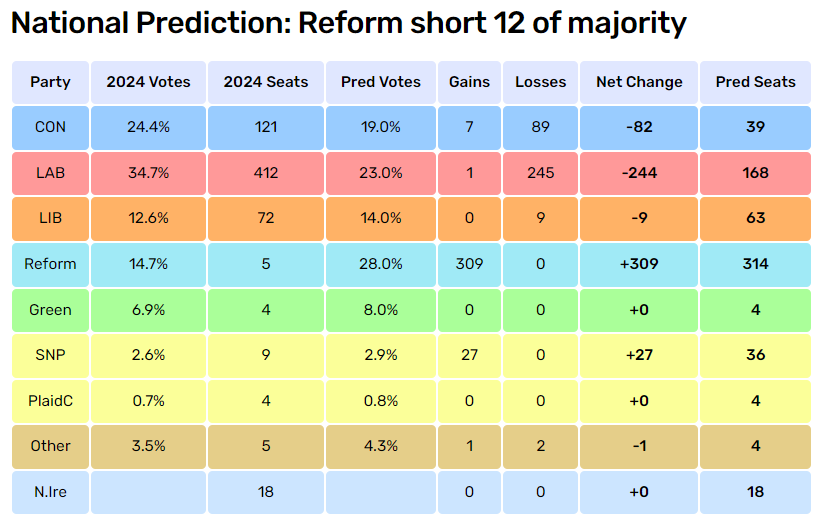Pollster: Techne
Sample size: 1,635
Fieldwork dates: 7th - 8th May 2025
Source
Key points
Have Reform mobilised a latent right-wing youth presence?
Class patterns remain discernible - but the education patterns have been disturbed.
Pay attention to the “Don’t Knows” - they’re still a sizeable proportion.
This is a big bounce compared to Techne’s previous poll on 24th April; the fieldwork took place nearly a week after the local elections, by which time it would normally be expected for a bounce to start deflating.
But it looks like Reform is not slowing down, and the gap between Reform and the other parties has only widened. Whereas before they were neck-and-neck, now the gap has widened in both directions, with both “heritage” parties slipping in the polls while Reform rises.
What would this parliament look like?
Electoral Calculus puts Reform just shy of a majority, with the Conservatives disappearing to third place and Labour’s presence being slashed by two-thirds:
Quite a common occurrence in recent polls seems to be the treacherous tightrope of First Past the Post: both sides distort the popular vote, with only one side of the distortion being favourable. The story that keeps coming out is that the Conservatives seem to be falling onto the wrong side, with a wider level of public support than the Liberal Democrats, but ending up with fewer seats, indicating a broad but increasingly shallow voter base.
On the other side of that tightrope, the Liberal Democrats seem to have formed a narrow, but very deep, voter base. The social media antics of Ed Davey might be embarrassing, but most voters don’t see them, and so their impact is questionable. At the very least, the gap between the Lib Dems and the Tories is shrinking, increasingly.
The “Don’t Knows” are still remarkable however for their size; with nearly 40% undecided, and this being roughly analogous to the low turnout for the 2024 election, it makes the prediction of this poll really worth paying attention to.
Techne’s polling is usually quite interesting for its alignment with traditional patterns of voting behaviour; for example, right-leaning parties (the Conservatives and Reform) performing less well with younger voters and their vote share rising with the age groups.
For this reason, though, it should be noted how the Tories and Reform’s vote share amongst under 35s is collectively 39%, which is higher than historic voting patters, when the Conservatives’ share of the youth vote was dwarfed by the Labour vote share. Perhaps this indicates, as social media intimates, that Reform has mobilised a latent right-wing presence amongst the youth.
I keep making this point but the trend amongst women really needs paying attention to; all polling in May so far has put Reform first amongst women. This bucks an historic trend in Britain that women voters prefer left-wing parties, and tracks more in line with recent Continental and American developments that make women (especially white women) more inclined to vote for right-wing parties and candidates.
But one of the reasons I like Techne’s polls is their consideration of education level. The historic trend is that least-educated voters are more likely to vote for right-wing parties, especially of the populist type, and that seems to be consistent here, with the “most educated” preferring Labour - but not by much at all.
However, the averagely educated - i.e. those educated to A Level, Apprenticeship, or College standard - are preferring Reform by a significant margin. Reform are leading amongst this group by 16%, which is remarkable, as this is complicates a neat linear relationship between education level and support for parties.
But looking at the socio-economic status of voters, one can see why right-wing populist parties are likely to do well; because while right-wing parties typically receive high levels of support from the more wealthy or more higher status, right-wing populist parties receive significant support from the low-to-medium voter - which is where the majority of voters, inevitably, are.
This, aligned with high levels of support amongst the least-educated and the average-educated voter, explains why populist-right voters break through.
Thank you for reading this short Poll Watch post, in which I look at and discuss the most recent public opinion survey. Please consider subscribing to and sharing this blog and, if you’re feeling particularly generous, subscribing to my paid content -(detailed research and policy proposals).


